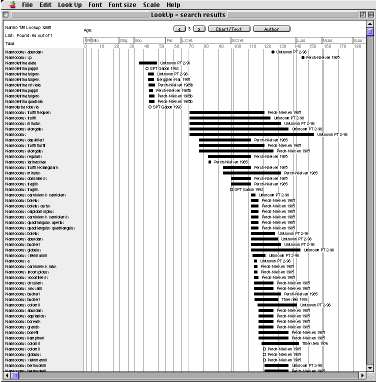Instructions:
Open a look-up table formatted as a tab-delimited ASCII TEXT file that
contains the attribute data. Then enter a name to look-up, a list of names
to simutaneously look-up or open a file containing a list of names to look-up. Lists copied from WellPlot may be batch looked-up using "Find clipboard list" or you may search for a single taxon using "Find a single species". Both dialogs provide filtering criteria such as
upper case, lower case, exact binomial match, match genus only and match
species only. Several features aid in matching taxa with minor spelling
differences.
The look-up table must be organized into a file with at least two columns
as follows:
Name[tab]attribute data[return]
1) The first column of the lookup table contains names or id,
multiple entries (rows)
of the same name will be found.
2) The remaining attribute data may have any format,
i.e. it may (should)
be multiple columns of data.
3) Open a file containing a list of names to find in the lookup table;
Look-up a list
on the clipboard or look for single taxa.
The list may be taxa names or ID numbers.
The format must
match exactly the format of the look-up table for exact matches.
Use the
search options for partial matches to names.
4) Save graphical or text results to a file (or copy to the clipboard):
Graphical data output is formatted as vector PICT.
Text data output is formatted as:
Names[tab]attribute data[return]
If the attribute data was formatted as muliple columns in the look-up
table, it will be multiple columns in the output.
Chart features:
Attribute data must be in the following order for the chart feature
to function properly:
Name[tab]BaseAge#[tab]BaseAgeName[tab]TopAge#[tab]TopAgeName[tab]additional
attribute data¶
The last column of data may be displayed as text on the chart. For example, if you want the author of the information displayed save it
as the last column of the look-up table. If you want location data displayed, save location as the last column.
Ranges are displayed as bars spanning from the LAD (top) age to the
FAD (old) age.
Open circles indicate only a citation for the LAD (top) age.
Filled circles indicate only a citation for the FAD (old) age.
Features:
•Look-up a single species
•Look-up a list of species from a text file
•Look-up a list of species from the clipboard
•Re-find the edited clipboard list
•Re-find only the list of taxa not-found in the pervious search
•Match case (Upper case, proper case, or as entered)
•Match Whole name (entire taxa name)
•Match Genus only (Genus name taken as left word or portion,
e.g.
search for "Aln" to find Alnus and Alnipollenites)
•Match species name (Species name= entire taxa name-genus name)
•Strip Latin endings (compare species epithet without often confused
latin endings)
•Strip control characters (if Lookup table is from DOS, UNIX or mainframe
platform)
•Age scale for graphical comparison (Built-in: SEPM, 1995; Gradstein
& Ogg, 1996)
•Variable font and font size
•Select from all available fonts
•Home, end, page up, page down and arrow keys navigate through window
contents.
Strip Latin endings:
This feature allows successful matching of similar epithets. Often
confused latin endings are removed from both the search entries and the
lookup table entries.
Below is a list of 10 latin endings that are removed:
-sis, -iae, -er, -um, -us, -is, -se, -ii, -i, -a
For example the following epithets will match with Strip endings turned
on:
striatum, striata, striatus
cooksoniae, cooksonii, cooksoni
africaense, africaensis (although not reduced to epithet
stem, the match is successful).
Functions:
•Finds species attributes from a look-up table.
•Get look-up tables from databases such as Palynodata or from personal databases.
•Look-up species lists from WellPlot 4 or
copy information to the clipboard from WellPlot.
Use DataReporter 3 or WellPlot
4 to create lists of names from spreadsheet data. |


![]() LookUp 2 for Mac OSX Intel & PPC Macs
LookUp 2 for Mac OSX Intel & PPC Macs ![]()
